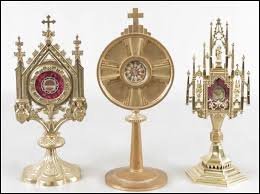HOLY, HOLY, HOLY IS . . . ?
After receiving Communion John stood up at the rail and reverently bowed towards the altar. Hadn’t he had just fed on the body and blood of God himself. After the service, in the coffee room, John was talking to the new vicar. After exchanging the usual pleasantries he was surprised to be asked,
“I hope you don’t mind my asking but why do you bow towards the front after you have received communion?”
“Well, er... it is reverent and I suppose it is to show my humble respect - doesn’t it?” he hesitatingly replied.
Later that week the vicar found himself having coffee at John’s home. The vicar explained the problem.
“At first it may seem rather pedantic to query such an action as bowing in church, but it can reveal some underlying misunderstandings about the New Testament teaching. Can you explain why you feel it is right?”
“Mmm...well if I am in church, in the most Holy part of it, in front of the Holy Altar, where I have just received the body and blood of Christ - isn’t it reasonable to show my worship physically as well as mentally?”
The conversation continued and out came the Bible and a concordance. They looked up all the references to “holy” in the New Testament. John was surprised to find that it was never used of objects or places but was only used of God, of His Word (the Scriptures) and of His people (the Christians) and their actions.
“Isn’t the altar holy then?” John inquired.
“No” was the simple reply, “holiness is a feature of God alone, but he has given this status to all true Christians. No inanimate object can be holy - those days have gone since Jesus came. In Old Testament times there was a holy temple with an altar and a Holy of Holies place. On the altar, sacrifices were offered to God, but now all this has changed. There are no holy buildings like the temple. Churches are similar to the synagogues which were primarily for teaching God’s word. The Bible teaches that the Christians now correspond to the temple, where God lives (2 Corinthians 6 v. 16) . That is why we are considered Holy. There are no altars any more as there are no sacrifices to be offered. The Old Testament sacrifices were a picture of the great sacrifice that Jesus made once for all for the sins of many (Hebrews 7 v. 27). Since then there has never been a need for altars again. At the communion service we remember that Jesus gave his body and blood for us, as a substitute. The bread and the wine remind us of this fact. In the Bible, Anglican prayer book, Thirty Nine Articles and the Catechism it is very clearly taught, that the presence of God is not in the bread and wine, but in the Christian who receives these tokens by faith, remembering what Jesus has done for him. The communion service really represents a feast where the Christians together remember that death on the cross. Indeed in the early church they used to combine this remembrance with a real meal. That is why we call the piece of furniture on which the bread and wine are placed a table, the communion table. It is however just an ordinary table like any other! So do you see why it is not good practice to bow or genuflect towards the table or the bread and wine. They are simply objects. Bowing seems such a little thing, but the practice undermines the Bible teaching and that is why I have bothered to bring the matter up.”
John was still somewhat puzzled by the discrepancy between what he had seen others do in church and the Biblical explanation he had just received from his vicar. He queried,
“But surely many churches still have Holy places, Holy objects and even Holy icons. Where do these ideas come from then?”
“Not from the Scriptures nor from the prayer book, I’m afraid to say”, replied the vicar.
The rubric at the end of the communion service in the Prayer Book says:-
“The sacramental bread and wine remain still in their very natural substance and therefore may not be adored (for that were idolatry to be abhored of all faithful Christians); and the natural body and blood of our Saviour Christ are in heaven and not here, it being against the truth of Christ’s natural body to be at one time in more places than one.”
All the way through church history people have gone beyond what the apostles were told to pass on to us. Perhaps a good verse for us all to remember with regard to practices such as these is 1 Corinthians 4 v. 6 which says
“. . . so that you may learn from us the meaning of the saying “Do not go beyond what is written””.
Scripture must always be the benchmark by which we determine our doctrine and practices. In 2 Timothy 3 v. 15 the scriptures are called Holy because they have come directly from God himself. They are God-breathed. Jesus himself gave the prescription “Search the Scriptures” (John 5 v. 39) as this is the only reliable way we can know the mind of God on any matter. It is these Scriptures that teach us to perpetually worship, serve and enjoy Jesus our God, our Saviour and our friend. Venerating religious objects even if related in some way to Him cannot be approved from Scripture and this is why churches that major on teaching people the Word of God do not do such things”.
BVP
